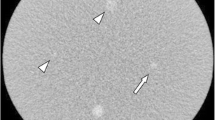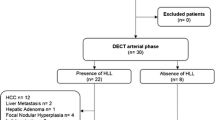Abstract
Objectives
To investigate the impact of an adaptive statistical iterative reconstruction (ASiR) algorithm on diagnostic accuracy and confidence for the diagnosis of hypervascular liver tumours, as well as the reader’s perception of image quality, using a low tube voltage (80 kVp), high tube current computed tomography (CT) technique.
Methods
Forty patients (29 men, 11 women) with 65 hypervascular liver tumours underwent dual energy CT. The 80 kV set of the dual energy acquisition was reconstructed with standard filtered backprojection (FBP) and ASiR at different blending levels. Lesion contrast-to-noise ratio (CNR), reader’s confidence for lesion detection and characterisation, and reader’s evaluation of image quality were recorded.
Results
ASiR yielded significantly higher CNR values compared with FBP (P < 0.0001 for all comparisons). Reader’s perception of lesion conspicuity and confidence in the diagnosis of malignancy were also higher with 60 % and 80 % ASiR, compared with FBP (P = 0.01 and < 0.001, respectively). Compared with FBP, ASiR yielded nearly significantly lower specificity for lesion detection and a substantial decrease in the reader’s perception of image quality.
Conclusions
Compared with the standard FBP algorithm, ASiR significantly improves conspicuity of hypervascular liver lesions. This improvement may come at the cost of decreased specificity and reader’s perception of image quality.
Key Points
• Adaptive statistical iterative reconstruction algorithms (ASiRs) offer increasing potential in multidetector CT.
• An ASiR algorithm significantly improves conspicuity of hypervascular liver lesions at MDCT.
• Improved lesion conspicuity translates into increased reader’s confidence for diagnosis of malignancy.
• False positive findings may increase with ASiR, leading to potentially lower specificity.




Similar content being viewed by others
Abbreviations
- FBP:
-
Filtered backprojection
- ASiR:
-
Adaptive statistical iterative reconstruction algorithm
References
Schindera ST, Nelson RC, Mukundan S et al (2008) Hypervascular liver tumors: low tube voltage, high tube current multi-detector row CT for enhanced detection—phantom study. Radiology 246:125–132
Marin D, Nelson RC, Samei E et al (2009) Hypervascular liver tumors: low tube voltage, high tube current multidetector CT during late hepatic arterial phase for detection—initial clinical experience. Radiology 251:771–779
Huda W, Scalzetti EM, Levin G (2000) technique factors and image quality as functions of patient weight at abdominal CT. Radiology 217:430–435
Thibault JB, Sauer KD, Bouman CA, Hsieh J (2007) A three-dimensional statistical approach to improved image quality for multislice helical CT. Med Phys 34:4526
Hara AK, Paden RG, Silva AC, Kujak JL, Lawder HJ, Pavlicek W (2009) Iterative reconstruction technique for reducing body radiation dose at CT: feasibility study. AJR Am J Roentgenol 193:764–771
Singh S, Kalra MK, Hsieh J et al (2010) Abdominal CT: comparison of adaptive statistical iterative and filtered back projection reconstruction techniques. Radiology 257:373–383
Sagara Y, Hara AK, Pavlicek W, Silva AC, Paden RG, Wu Q (2010) Abdominal CT: comparison of low-dose CT with adaptive statistical iterative reconstruction and routine-dose CT with filtered back projection in 53 patients. AJR Am J Roentgenol 195:713–719
Prakash P, Kalra MK, Kambadakone AK et al (2010) Reducing abdominal CT radiation dose with adaptive statistical iterative reconstruction technique. Investig Radiol 45:202
Mitsumori LM, Shuman WP, Busey JM, Kolokythas O, Koprowicz KM (2012) Adaptive statistical iterative reconstruction versus filtered back projection in the same patient: 64 channel liver CT image quality and patient radiation dose. Eur Radiol 22:138–143
Marin D, Nelson RC, Schindera ST et al (2010) Low-tube-voltage, high-tube-current multidetector abdominal CT: improved image quality and decreased radiation dose with adaptive statistical iterative reconstruction algorithm—initial clinical experience. Radiology 254:145–153
Bossuyt PM, Reitsma JB, Bruns DE et al (2003) Towards complete and accurate reporting of studies of diagnostic accuracy: the STARD initiative. Clin Chem Lab Med 41:68–73
Sultana S, Awai K, Nakayama Y et al (2007) Hypervascular hepatocellular carcinomas: bolus tracking with a 40-detector CT scanner to time arterial phase imaging. Radiology 243:140–147
Miéville FA, Ayestaran P, Argaud C et al (2010) Potential benefit of the CT adaptive statistical iterative reconstruction method for pediatric cardiac diagnosis. Proc SPIE 7622:2D1–2D11
Couinaud C (1957) Le foie: etudes anatomiques et chirurgicales. Masson et Cie, Paris
Bismuth H (1982) Surgical anatomy and anatomical surgery of the liver. World J Surg 6:3–9
Nino-Murcia M, Olcott EW, Jeffrey RB, Lamm RL, Beaulieu CF, Jain KA (2000) Focal liver lesions: pattern-based classification scheme for enhancement at arterial phase CT. Radiology 215:746–751
Medical imaging: the assessment of image quality (report no. 54). International Commission on Radiation Units and Measurements. Bethesda, MD: International Commission on Radiation Units and Measurements, 1996
Jessen K, Panzer W, Shrimpton P et al (2000) EUR 16262: European guidelines on quality criteria for computed tomography. Office for Official Publications of the European Communities, Luxembourg
Obuchowski NA, Rockette HE (1995) Hypothesis testing of the diagnostic accuracy for multiple diagnostic tests: an ANOVA approach with dependent observations. J Stat Comput Simul 24:285–308
Pinheiro J, Bates D, DebRoy S, Sarkar D; the R Development Core Team (2012) nlme: linear and nonlinear mixed effects models. R package version 3.1-105
Kulkarni NM, Uppot RN, Eisner BH, Sahani DV (2012) radiation dose reduction at multidetector CT with adaptive statistical iterative reconstruction for evaluation of urolithiasis: how low can we go? Radiology 265:158–166
Brancatelli G, Baron RL, Peterson MS, Marsh W (2003) Helical CT screening for hepatocellular carcinoma in patients with cirrhosis: frequency and causes of false-positive interpretation. AJR Am J Roentgenol 180:1007–1014
Hayashi PH, Trotter JF, Forman L et al (2004) Impact of pretransplant diagnosis of hepatocellular carcinoma on cadaveric liver allocation in the era of MELD. Liver Transpl 10:42–48
Freeman RB, Mithoefer A, Ruthazer R et al (2006) Optimizing staging for hepatocellular carcinoma before liver transplantation: a retrospective analysis of the UNOS/OPTN database. Liver Transpl 12:1504–1511
Richard S, Husarik DB, Yadava G, Murphy SN, Samei E (2012) Towards task-based assessment of CT performance: system and object MTF across different reconstruction algorithms. Med Phys 39:4115
Guimarães LS, Fletcher JG, Harmsen WS et al (2010) Appropriate patient selection at abdominal dual-energy CT using 80 kV: relationship between patient size, image noise, and image quality. Radiology 257:732–742
Acknowledgements
This study received equipment and financial support from GE Healthcare, Inc. (Milwaukee, USA). The authors had control of the data and the information submitted for publication. Two authors of the study were, respectively, an employee (J.G.C.) and a medical consultant (R.C.N.) to GE Healthcare. Another author (D.M.), who is not an employee of or a consultant for GE Healthcare, had control of inclusion of any data and information that might present a conflict of interest.
Author information
Authors and Affiliations
Corresponding author
Rights and permissions
About this article
Cite this article
Marin, D., Choudhury, K.R., Gupta, R.T. et al. Clinical impact of an adaptive statistical iterative reconstruction algorithm for detection of hypervascular liver tumours using a low tube voltage, high tube current MDCT technique. Eur Radiol 23, 3325–3335 (2013). https://doi.org/10.1007/s00330-013-2964-1
Received:
Revised:
Accepted:
Published:
Issue Date:
DOI: https://doi.org/10.1007/s00330-013-2964-1




